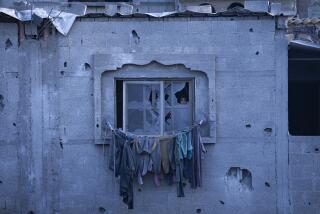THE CHILDREN OF THE HOLOCAUST :...
- Share via
Yes, every day someone publishes a new Holocaust book. Yes, we already know the worst and the worst beyond that. Yes, the heart and the mind can stand only so much. One day we will be ready to go on, to let history bind the wound, but not yet. Now, at the end of the 20th Century, we are still documenting, remembering, honoring, uncovering. We remain stunned and we cannot turn away, not while the last survivors speak, not while there is still history to be recovered, words to be heard.
Dr. Adina Blady Szwajger’s memoir of the Warsaw ghetto, “I Remember Nothing More,” is a significant and powerful book adding to our historical knowledge and emotional understanding of the Jewish Resistance. She was 22 years old, about to complete her medical training, when the Nazis invaded Poland. She joined the staff of the Warsaw Children’s hospital and remained there till the last days of the ghetto when she escaped to the Aryan side and became a courier for the Resistance, bringing money and papers, arranging apartments for hidden Jews, dealing with extortionists, betrayers and Nazis.
After the war, she became a prominent pediatrician in Warsaw, and now, in her 70s, she tells us of things she can hardly bear to remember. With directness, honesty, with a certain artless quality, where events unfold and rush ahead and pause where the feelings become too large for speech, she tells about the starving children whom the staff at the hospital could not feed, about the tubercular wards on which every patient died.
She describes the staff efforts to do rounds, to practice medicine in a situation where to save a child meant to condemn him to a different death. She describes her colleagues, breaking down, going on; the typhus, the scarlet fever; the children putting on plays hours before deportation. At great cost to herself, she describes giving lethal injections of morphine to the elderly who could not move, to dying babies, as the Nazis arrive to clear out the hospital. Later, she performed abortions to save the lives of women in hiding.
She tells us at the end of the book the memory that has weighed down on her all the rest of her life. She gave a lethal injection to an old woman who was running in the Warsaw streets, speaking Yiddish and so threatening to betray a household of hidden Jews. We understand. We do not judge. We would hope to have had her courage to do the same.
She describes her Polish friends and enemies in a city become hostile and dark. She tells us how they drank vodka to tolerate the nights and how they loved one another in the face of chaos.
This book has no philosophy, no hand-wringing, no adjectives, no theology, no politics. It is simply an extraordinary book by an extraordinary woman. Her story deserves a prominent place in the terrible library of the Shoah.
In “Children of the Flames: Dr. Joseph Mengele and the Untold Story of the Twins of Auschwitz,” we hear the story of the infamous Mengele, the Angel of Death at Auschwitz, and his special children. Surviving twins tell us in their own words what they remember of their experiences as part of Mengele’s genetic experiments in racial superiority. We learn how they picked up their lives and continued in a nightmare beyond the complete understanding of those of us who did not experience it.
Lucette Matalon Lagnado, who had written a story on Mengele for Parade magazine, and Sheila Cohn Dekel, the widow of a surviving twin, have written a book that tells us in detail of the life of the children who were saved from the gas chambers to participate in Mengele’s laboratory. We are told of injections and operations and painful eye drops, the castration of a surviving twin’s brother, the operations without anesthetic, the bruises, the brutality, the deliberate infections that were given to the twins in the name of eugenics, in the name of science and racial genetics.
The book also explores the family background, character and fate of Mengele himself, this charming, elegant, ambitious doctor who turned into one of the century’s worst monsters. In this readable and often gripping book, the story of Mengele’s life is interwoven with the words of his child victims. Sometimes the device is heavy, but often it serves to highlight the mystery and the horrors. We see Mengele in his final years, alone, bitter, given to his usual rages and hollow flirtations. We learn how he slipped through Allied hands and how his loving family protected him through the years. We see his obese mother and his successful father and his confused and needy son.
As the twins speak of their adult breakdowns and their difficulties in living with their memories, we see Mengele in hiding, not happy, but not unhappy enough. We learn how the anti-Semitic uprising in South America, after the capture of Adolph Eichmann, caused Ben Gurion to call off the hunt for Mengele.
This book is written simply and clearly, without interpretation or historical analysis. It is a journalist’s story, written for the general public. Even though most all of the information has been reported many times over and the experience of the twins is already known, this book will shake and move and interest new readers. It can be easily understood by teen-agers and others who are beginning to discover the bleak depths of our recent history.
While the book does not solve the puzzle of how Mengele became Mengele, how evil erupted at that time, in that way, it can bring to a wider public the facts that should be heard and repeated again and again for the safety and the sanity of future generations.
Only 10% of European Jewish children who were alive in 1939 survived the war. One-and-a-half million were killed. Deborah Dwork reconstructs the story of their lives in “Children With a Star: Jewish Youth in Nazi Europe.”
Working through survivors’ memoirs, personal interviews, institutional accounts and other histories, she describes the move from what she calls the recognizable world into one of hiding; internment in the ghettos, in the transit camps, finally in the death camps. She has written detailed accounts of operations to rescue children. She has documented the activities of Gentile women who risked their lives finding places for children.
She describes a history of women’s rescue work that has been largely neglected by historians who prefer to concentrate on the more obviously masculine heroics of armed resistance. She talks of the incredible bravery and pain of mothers who relinquished their children to strangers in the hopes of saving their lives. She writes of the psychological effects on children who were forced to hide their identities or were hidden altogether away from the world.
The story of the organizations that tried to help--and did save some--is an important one. The story of the network of individuals and offices that participated in the rescue work is an important part of the history of events.
She records the starvation and humiliations of ghetto life as well as the attempts at normalcy, as children played and worked in schools. She describes the experience of the few early adolescents who were able to pass through the camp selections and survive.
To view the Holocaust through the eyes of children is to see it for all its madness and injustice. It is impossible to read this book without raging again at the facts we already know. The helplessness and innocence of children make the history of 1935-1945 particularly incomprehensible. While this book records little that readers of Holocaust literature do not already know, she has contributed a child’s history of the Holocaust that can be read by students, psychologists, historians in years to come. The excellent quality of the research and the clarity of the writing make this an effective book, adding a point of view that is essential for us as we continue to witness the past, to wrestle with the facts.
Even when the last of the survivors die, even when the immediate passion cools, even as other tragedies occur, this Shoah will serve as a mirror of humanity’s other face, a face that will remain until the sun burns out.
More to Read
Sign up for our Book Club newsletter
Get the latest news, events and more from the Los Angeles Times Book Club, and help us get L.A. reading and talking.
You may occasionally receive promotional content from the Los Angeles Times.








